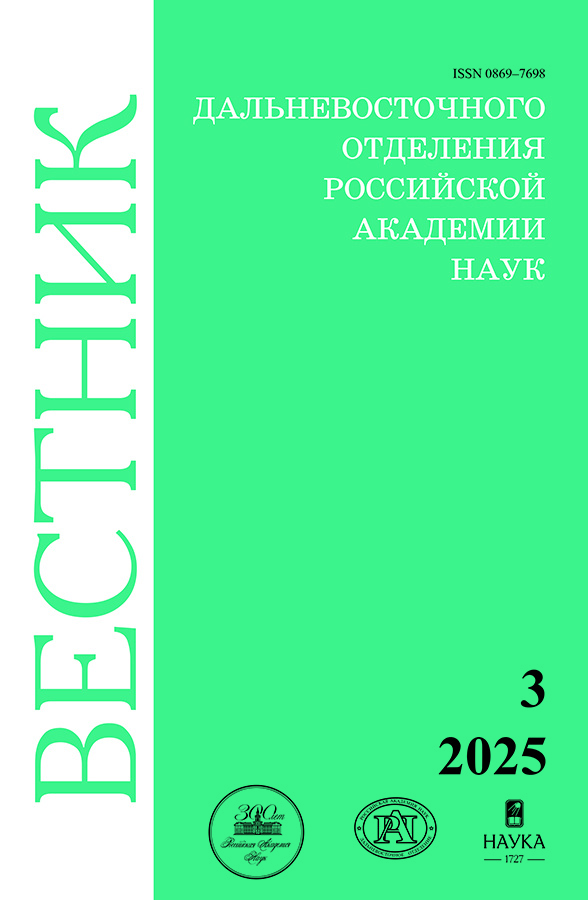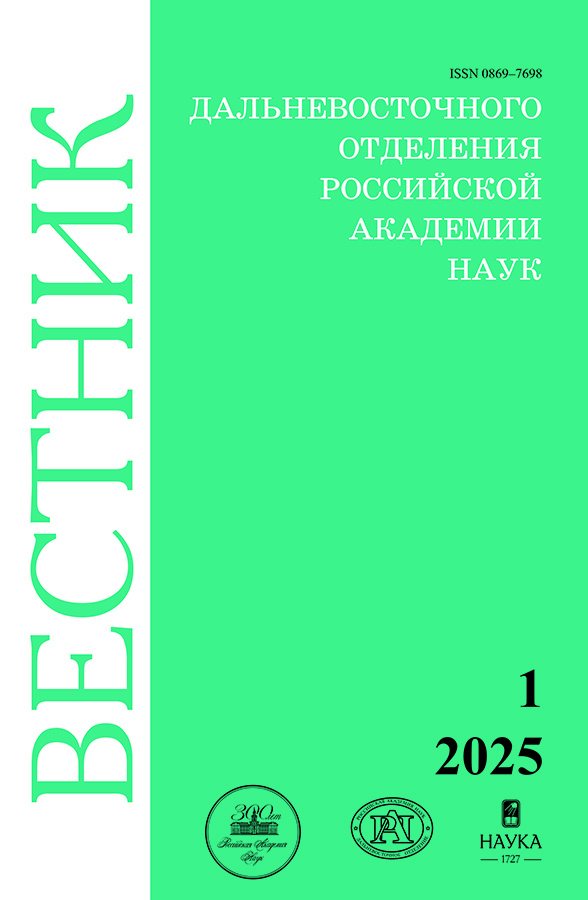The influence of soil composition on the growth and development of basil plants
- Authors: Kulchin Y.N.1, Kozhanov S.O.1, Kholin A.S.1, Subbotin E.P.1, Subbotina N.I.1
-
Affiliations:
- Institute of Automation and Control Processes of FEB RAS
- Issue: No 1 (2025)
- Pages: 5-18
- Section: Biotechnology
- URL: https://modernonco.orscience.ru/0869-7698/article/view/688861
- DOI: https://doi.org/10.31857/S0869769825010012
- EDN: https://elibrary.ru/HINDDO
- ID: 688861
Cite item
Full Text
Abstract
The paper studies the development of basil plants (Ocimum basilicum L.) depending on the composition of the soil mixture when grown using LED radiation in closed conditions. The effect of combinations of Crystalon and Zion fertilizers with sand on plants was studied. It was shown that the use of the complex Crystalon fertilizer leads to the highest values of morphometric parameters of basil plants. The plants grown with its help had values of the mass of the above-ground part of the plants 45 times greater than the control. The use of Zion fertilizer led to an increase in this parameter relative to the control by 11 times. The addition of sand to the mixture contributed to a decrease in the mass of the above-ground part of basil plants grown in a soil mixture with Crystalon by 15%, Zion 37%, and in a soil mixture without additives by 7%. The use of Crystalon fertilizer made it possible to grow basil plants with an above-ground mass of 14 g on the 35th day, which is comparable to the results obtained using soilless methods. This result shows the potential of using Crystalon fertilizer for growing this crop in the soil in a short time, while maintaining all the advantages of this method.
Keywords
Full Text
About the authors
Yuri N. Kulchin
Institute of Automation and Control Processes of FEB RAS
Author for correspondence.
Email: kulchin@iacp.dvo.ru
ORCID iD: 0000-0002-8750-4775
Academician of the RAS, Doctor of Sciences in Physics and Mathematics
Russian Federation, VladivostokSergey O. Kozhanov
Institute of Automation and Control Processes of FEB RAS
Email: kozhanov_57@mail.ru
ORCID iD: 0009-0001-2629-3521
Junior Researcher
Russian Federation, VladivostokAlexander S. Kholin
Institute of Automation and Control Processes of FEB RAS
Email: a_kholin@dvo.ru
ORCID iD: 0000-0002-9751-5136
Researcher
Russian Federation, VladivostokEvgeny P. Subbotin
Institute of Automation and Control Processes of FEB RAS
Email: s.e.p@list.ru
ORCID iD: 0000-0002-8658-3504
Candidate of Physics and Mathematics, Leading Researcher
Russian Federation, VladivostokNatalia I. Subbotina
Institute of Automation and Control Processes of FEB RAS
Email: sale789@mail.ru
ORCID iD: 0000-0003-0945-3877
Junior Researcher
Russian Federation, VladivostokReferences
- Bridgewood L. Hydroponics: Soilless gardening explained. Marlborough, UK: Crowood Press; 2003. 141 p.
- Fussy A., Papenbrock J. An overview of soil and soilless cultivation techniques – chances, challenges and the neglected question of sustainability. Plants. 2022;11(9):1153. https://doi.org/10.3390/plants11091153.
- Geilfus C.M. Controlled environment horticulture. In: Improving Quality of Vegetables and Medicinal Plants. Cham, Switzerland: Springer; 2019. P. 1–233. https://doi.org/10.1007/978-3-030-23197-2.
- Khan F.A. A review on hydroponic greenhouse cultivation for sustainable agriculture. International Journal of Agriculture Environment and Food Sciences. 2018;2(2):59–66. https://doi.org/10.31015/jaefs.18010.
- Sgherri C., Cecconami S., Pinzino C., Navari-Izzo F., Izzo R. Levels of antioxidants and nutraceuticals in basil grown in hydroponics and soil. Food Chemistry. 2010;123(2):416–422. https://doi.org/10.1016/j.foodchem.2010.04.058.
- Maurer D., Sadeh A., Chalupowicz D., Barel S., Shimshoni J.A., Kenigsbuch D. Hydroponic versus soil-based cultivation of sweet basil: impact on plants’ susceptibility to downy mildew and heat stress, storability and total antioxidant capacity. Journal of the Science of Food and Agriculture. 2023;103(15):7809–7815. https://doi.org/10.1002/jsfa.12860.
- Fontana E., Nicola S. Traditional and soilless culture systems to produce corn salad (Valerianella olitoria L.) and rocket (Eruca sativa Mill.) with low nitrate content. J. Food Agric. Environ. 2009;7(2):405–410.
- Buitrago-Villanueva I., Barbosa-Cornelio R., Coy-Barrera E. Influence of the Culture System and Harvest Time on the Specialized Metabolite Composition of Rocket Salad (Eruca sativa) Leaves. Horticulturae. 2023;9(2):235. https://doi.org/10.3390/horticulturae9020235.
- Tavakkoli E., Rengasamy P., McDonald G.K. The response of barley to salinity stress differs between hydroponic and soil systems. Functional Plant Biology. 2010;37(7):621–633. https://doi.org/10.1071/FP09202.
- Makri O., Kintzios S. Ocimum sp. (basil): botany, cultivation, pharmaceutical properties, and biotechnology. J. Herbs, Spices Med. Plants. 2008;13(3):123–150. https://doi.org/10.1300/J044v13n03_10.
- Golubkina N.A., Malankina E.L., Solov’eva A.D., Kosheleva O.V., Krivenkov L.V., Dobrutskaya E.G. Akkumulirovanie selena bazilikom ogorodnym (Ocimum basilicum L.) = [Accumulation of selenium by garden basil (Ocimum basilicum L.)]. Ovoshchi Rossii. 2014;1(22):42–47. (In Russ.).
- Dou H., Niu G., Gu M., Masabni J.G. Responses of sweet basil to different daily light integrals in photosynthesis, morphology, yield, and nutritional quality. HortScience. 2018;53(4):496–503. https://doi.org/10.21273/HORTSCI12785-17.
- Beaman A.R., Gladon R.J., Schrader J.A. Sweet basil requires an irradiance of 500 μ mol· m-2· s-1 for greatest edible biomass production. HortScience. 2009;44(1):64–67. https://doi.org/10.21273/HORTSCI.44.1.64.
- Sipos L., Balázs L., Székely G., Jung A., Sárosi S., Radácsi P., Csambalik L. Optimization of basil (Ocimum basilicum L.) production in LED light environments. A review. Scientia Horticulturae. 2021;289:110486. https://doi.org/10.1016/j.scienta.2021.110486.
- Barbi S., Barbieri F., Bertacchini A., Barbieri L., Montorsi M. Effects of different LED light recipes and NPK fertilizers on basil cultivation for automated and integrated horticulture methods. Applied Sciences. 2021;11(6):2497. https://doi.org/10.3390/app11062497.
- Aghaye Noroozlo Y., Souri M.K., Delshad M. Effects of soil application of amino acids, ammonium, and nitrate on nutrient accumulation and growth characteristics of sweet basil. Communications in Soil Science and Plant Analysis. 2019;50(22):2864–2872. https://doi.org/10.1080/00103624.2019.1689249.
- Jabborova D., Ma H., Bellingrath-Kimura S.D., Wirthn S. Impacts of biochar on basil (Ocimum basilicum) growth, root morphological traits, plant biochemical and physiological properties and soil enzymatic activities. Scientia Horticulturae. 2021;290:110518. https://doi.org/10.1016/j.scienta.2021.110518.
- Sabra M., Aboulnasr A., Franken P., Perreca E., Wright L.P., Camehl I. Beneficial root endophytic fungi increase growth and quality parameters of sweet basil in heavy metal contaminated soil. Frontiers in Plant Science. 2018;9:1726. https://doi.org/10.3389/fpls.2018.01726.
- Chomczyńska M., Zdeb M. The effect of Z-ion Zeolite substrate on growth of Zea mays L. as energy crop growing on marginal soil. Journal of Ecological Engineering. 2019;20(9):253–260. https://doi.org/10.12911/22998993/112482.
- Kasandrovich S.Y., Ionova O.V., Soldatov V.S. Kompozitnye ionitnye substraty na osnove polimernogo ionita i prirodnogo klinoptilolita = [Composite Ion Exchange Substrates Based on Polymeric Ion Exchanger and Natural Clinoptilolite]. Proceedings of the National Academy of Sciences of Belarus. Chemical Series. 2017;4:7–14. (In Russ.). URI: https://vestichem.belnauka.by/jour/article/view/282?locale=en_US (date of access 02.12.2024).
- Chomczyńska M., Soldatov V., Wasąg H., Turski M. Effect of ion exchange substrate on grass root development and cohesion of sandy soil. Int. Agrophys. 2016;30(3):293–300. https://doi.org/10.1515/intag-2015-0095.
- Soldatov V., Pawlowski L., Szymanska M., Chomczyńska M., Matusevich V., Wasag H., Machon A., Kowalik H., Kobusinski P. Application of ion exchange substrates Biona for fertilization of depleted soils and bare sand. Ecological Engineering. 2001;18(2):227–232. https://doi.org/10.1016/S0925-8574(01)00070-2.
- Mamiev D.M., Kumsiev E.I., Shalygina A.A. Ehffektivnost’ biopreparata Ehkstrasol i mikroudobreniya Kristalon na posevakh kukuruzy = [Efficiency of the biopreparation Extrasol and microfertilizers Kristalon on corn crops]. Gornoe Sel’skoe Khozyaistvo. 2016;1:102–108. (In Russ.).
- Mamiev D.M., Doeva L.Y., Misik N.A., Tedeeva A.A., Shalygina A.A. Primenenie biopreparata Ehkstrasol i mikroudobreniya Kristalon na posevakh kukuruzy = [Application of the biopreparation Extrasol and microfertilizers Kristalon on corn crops]. Zemledelie. 2011;2:29–31. (In Russ.).
- Galimov V.R., Glaz N.V., Ufimtseva L.V. Razvitie sazhentsev vishni v zavisimosti ot mineral’nykh podkormok i podvoinykh kombinatsii = [Development of cherry seedlings depending on mineral fertilizers and rootstock combinations]. Glavnyi Agronom. 2019;3. (In Russ.).
- Kulchin Y.N., Bulgakov V.P., Subbotin E.P. Kholin A.S., Subbotina N.I. Monochromatic LEDs Effect on Rocket (Eruca sativa Mill.) Morphogenesis and Productivity. Bulletin of the Russian Academy of Sciences: Physics. 2022;86:S114–S118. https://doi.org/10.3103/S1062873822700502.
- Shipley B., Vu T.-T. Dry matter content as a measure of dry matter concentration in plants and their parts. New Phytologist. 2002;153:359–364. https://doi.org/10.1046/j.0028-646X.2001.00320.x.
- Maeda K., Ahn D.-H. Estimation of Dry Matter Production and Yield Prediction in Greenhouse Cucumber without Destructive Measurements. Agriculture. 2021;11:1186. https://doi.org/10.3390/agriculture11121186.
- Abbasvand E., Hassannejad S., Zehtab-SalmasiS., Alizadeh-Salteh S. Physiological and biochemical responses of basil to some allelopathic plant residues and dodder infestation. Acta Physiologiae Plantarum. 2020;42:1–13. https://doi.org/10.1007/s11738-019-2990-y.
- Ghazijahani N., Hadavi E., Jeong B.R. Foliar sprays of citric acid and salicylic acid alter the pattern of root acquisition of some minerals in sweet basil (Ocimum basilicum L.). Frontiers in Plant Science. 2014;5:573. https://doi.org/10.3389/fpls.2014.00573.
- Roosta H.R., Sajjadinia A.R. Studying the effect of cold stress on green basil, violet basil, tomato and lettuce using chlorophyll fluorescence technique. Environmental Stresses in Crop Sciences. 2010;3(1):1–8.
- Stetsenko L.A., Pashkovsky P.P., Voloshin R.A., Kreslavski V.D., Kuznetsov V.V., Allakhverdiev S.I. Role of anthocyanin and carotenoids in the adaptation of the photosynthetic apparatus of purple-and green-leaved cultivars of sweet basil (Ocimum basilicum) to high-intensity light. Photosynthetica. 2020; 58(4):890–901. doi: 10.32615/ps.2020.048.
- Piovene C., Orsini F., Bosi S., Sanoubar R., Bregola V., Dinelli G., Gianquinto G. Optimal red: blue ratio in led lighting for nutraceutical indoor horticulture. Scientia Horticulturae. 2015;193:202–208. https://doi.org/10.1016/j.scienta.2015.07.015.
- Pasch J., Appelbaum S., Palm H.W., Knaus U. Growth of basil (Ocimum basilicum) in aeroponics, DRF, and raft systems with effluents of African catfish (Clarias gariepinus) in decoupled aquaponics (ss). AgriEngineering. 2021;3(3):559–574. https://doi.org/10.3390/agriengineering3030036.
Supplementary files










